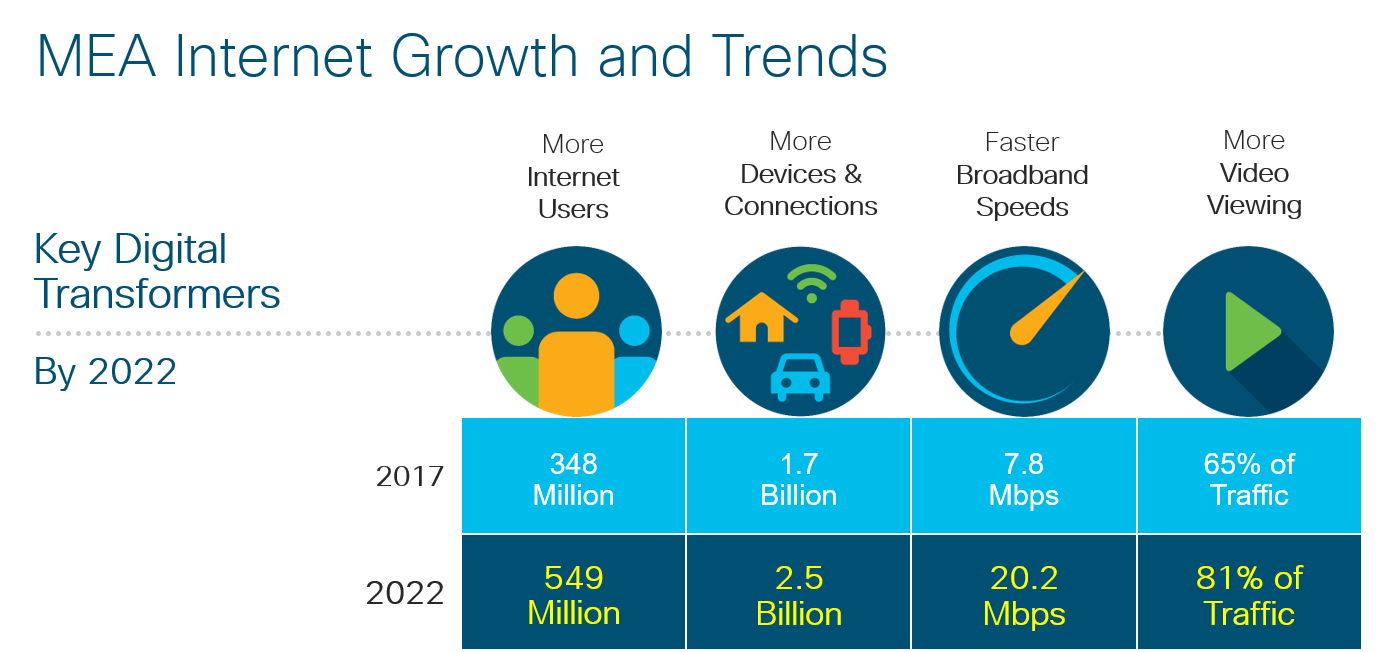Cisco’s Visual Networking Index (VNI) Forecast predicts 4.8 billion Internet users to be connected globally by 2022, out of which 549 million will be living in the Middle East and Africa.
At its “Cisco Connect: Say Hello to the Future” event, Cisco celebrated 30 years of the World Wide Web by sharing insights from the VNI Forecast to predict trends and behaviors evolving in the digital landscape in the region and globally.
Cisco’s VNI Forecast predicts four key drivers of IP traffic growth in the MEA region by 2022:
- A 9% increase in the number of Internet users
The number of people using the Internet will grow from 23% of the region’s population in 2017 to 32%.
Digitization features high on the national agendas of most of the region’s countries. Cisco estimates that MEA will have approximately 549 million Internet users and account for the highest growth rate in IP traffic, with a 41% increase over 2017.
- An increasing number of connections
Cisco predicts there will be approximately 2.5 billion devices connected to the network, equating to 1.4 networked devices per capita in MEA.
Non-PC devices will drive 91% of regional Internet traffic by 2022. With projected average mobile network connection speeds to grow by as much as 28%, smartphones in particular are expected to make up 79% of Internet traffic in MEA, with 1.2 trillion connected smartphones by 2022. Cisco anticipates the enhanced connectivity to create new possibilities for AI and Machine Learning across industries and in smart homes.
- Faster broadband speeds
As broadband connection speed is a key enabler for IP traffic growth, Cisco predicts the speeds will increase more than two-fold, from 2017 to 2022.
Accordingly, it is expected that broadband speeds in MEA will increase from 7.8Mbps in 2017 to 20.2Mbps by 2022 – enabling businesses and individuals to operate with greater speed and efficiency. As this speed continues to increase, large downloads will go from taking hours to a matter of minutes and eventually, seconds.
- More media-rich content and applications
In terms of rich media, data-heavy files and videos are anticipated to make up 81% of MEA’s IP traffic by 2022, up from 65% in 2017.
The predicted 16% increase in media-rich Internet traffic can be partially attributed to the rapid growth of OOT film, television and music streaming services in MEA. As online gaming also continues to grow in popularity, Cisco predicts that the region will experience a five-fold increase in Internet gaming traffic from 2017, making up 1 percent of total IP traffic in MEA by 2022.

Commenting on Cisco’s VNI Forecast and the changes predicted to affect MEA, David Meads, Vice President, Cisco Middle East and Africa said, “It is undeniable that the Internet is growing at an exponential rate. As governments continue to invest in infrastructure, a faster and stronger Internet opens the doors to unprecedented opportunities for individuals and industry alike. Digitization is a critical force for economic growth, so businesses must adopt a mindset that is proactive, rather than reactive. DDos attacks can represent up to 25% of a country’s total Internet traffic while they are occurring. By implementing the appropriate cyberdefense mechanisms, organizations can protect themselves throughout the full attack continuum – before, during and after an attack.”
“With nations such as the UAE championing innovation, the Internet has, and continues to change our lives in an infinite number of ways. Recognizing the changes that are affecting MEA, government, policymakers and service providers must continue to unite in their efforts to create an accessible Internet that is available to the masses, underpinned by a secure framework to aid sustainable growth.”
